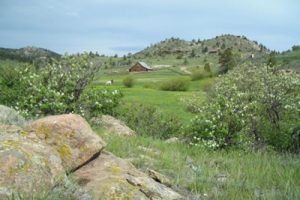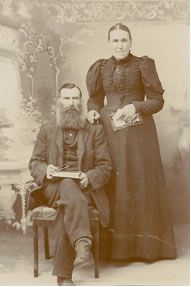The Solomon Batterson Ranch and Stage Station
Livermore, CO
History by Linda Adams
Table of Contents:
- The Solomon Batterson Ranch
- Solomon Batterson Ranch and Stage Station: National Register of Historic Places “Rural Historic Landscape”
The Solomon Batterson Ranch
(Read and download this section in PDF)

The Solomon Batterson Ranch, established ca. 1870, served as a stage stop and swing station on the old wagon road from The Forks to the gold rush boom town of Manhattan, down Pingree Hill to Rustic on the Cache la Poudre River and on up to Cameron Pass and North Park. In October 2010 the 13+acre ranch headquarters and meadow along the old stage road was listed as a “Rural Historic Landscape”—the first such designation in Colorado—on the National Register of Historic Places. It was recognized for its role in opening the transportation corridor through Livermore to the west for freighters, mail delivery, residents and tourists in the last quarter of the nineteenth century. In addition, the Batterson Barn, built in 1889-90 to accommodate increasing stage and freight traffic, was recognized as the best example of a Midwest Three-Portal style barn still standing in the region.
Solomon and Mary Batterson and their three children—William (Billy), Melissa Almina (“Mina”), and Azubah Ella (“Suba”)—were among Livermore’s earliest permanent settlers. Solomon (1830-1919) and Mary (1833-1910) were both of English and Scottish descent and both originally from Allegheny County, NY. They both grew up in farm families that had moved from state to state across the Midwest, eventually settling in Iowa where Solomon and Mary met. They were married on Christmas day, 1852 in Decorah, IA and continued to move around the upper Midwest looking for an ideal spot “to take up land.” Their three children were born between 1853 and 1868 in IA and MN.
In 1870, when Solomon was 40 and ‘Suba was just a toddler, they gave up on the Midwest and decided to head out to California. They drove two wagon teams and eight head of cattle and arrived in Fort Collins on August 11. They liked the country so well they decided to stay in what had become Colorado Territory only nine years before and wouldn’t be a state for another six years. Soon they discovered the Livermore park area and decided this was the place they had been looking for. They chose a site 10 miles west of the North Fork of the Cache la Poudre River and began dairying. Solomon and Billy hunted the abundant elk, deer, antelope and mountain sheep and sold it by the wagonload for 9 cents per pound in Cheyenne, Fort Collins, Greeley, and Denver. They tanned the hides from which Mary made buckskin suits. They first built a two-story log house 16’x24’ and later expanded with a 14’x16’ frame addition, a 12’x24’ milk room and a large outdoor cellar. Mary took in boarders and travelers. The original stone foundation is still visible from Red Feather Lakes Road.
In 1878 Solomon was milking 32 cows and Mary made and sold 3400 pounds of butter. The family was beginning to prosper. Tragedy struck however, just before Christmas, when 10 year-old Suba came down with a high fever. Young Charlie Roberts, son of another pioneer family, rode to Cheyenne to fetch a doctor, but they arrived back too late. The Fort Collins Courier reported that she died of intestinal intussusception. She is buried on the hillside just across Red Feather Lakes Road in the first marked grave in the area, with a beautiful white marble headstone and footstone.
On January 17, 1883 Billy Batterson married Lillian Edith Aldrich in Fort Collins in the presence of some 50 guests, including Mr. and Mrs. Ansel Watrous, who wrote the definitive history of Larimer County in 1911. A few weeks later on February 6, Lillian’s uncle William Edgar Tibbits married Billy’s sister, Almina, at the Batterson Ranch in Livermore. It was also Mary’s 50th birthday. Later that year, Solomon Batterson filed for his homestead quarter section (160 acres), then pre-empted another quarter section, then purchased two additional quarter sections bringing his holdings to 640 acres. Eventually the ranch encompassed some 800 acres of “the finest grazing land in the region.” His holdings were in sections 13, 14, 23, 24, and 25 which now include parts of Glacier View Meadows Filings 1, 4, 5, 8, 9, 10, and 12 as well as the private land along South Gordon Creek.
In 1885 after 15 years on the ranch, Batterson received a Government patent, signed by President Grover Cleveland. The next year gold was discovered to the west and the boom town of Manhattan sprang up. This substantially increased the traffic along the road and the Batterson Ranch became a swing station (where horses were changed) for the Manhattan Stage driven by James F. Vandewark. A few years later as tourism grew along the Elkhorn Creek and Poudre River, Casper Zimmerman’s stage made a stop at the Batterson Ranch for a fare of $1.75 for the 35 miles from Fort Collins.
In 1903 Solomon (age 73) and Mary, after more than 32 years on the ranch, sold the cattle, leased the ranch to their daughter Almina, her husband William Tibbits and their nine children, and moved to Fort Collins, where they built a 10-room brick home that still stands at 402 E. Oak Street kitty corner from the public library. This is where their son, Billy, died a mysterious and untimely death in 1908. Solomon and Mary suspected Billy’s hired man Will St. Clair had poisoned him, though it was never proven. Eighteen months later, only weeks after Mary’s own death, Will St. Clair married Lillian Aldrich Batterson and they continued to live on Billy Batterson’s prosperous ranch on Elkhorn Creek.
In 1916 John McNey II bought the ranch from Solomon. As John McNey lived in the family home on McNey Hill, he let his brother Stewart and wife Josephine McNey live in the old Batterson place with their son Lawrence. In 1917 they hosted a fundraising dance to buy seats for the Adams school house where Josephine was the teacher. On July 5, the 13-room house burned to the ground from a kitchen fire. Many items were saved from the fire and placed in the meadow across the road, but that night a flood came down Batterson Hill and washed away what hadn’t burned. The house was never rebuilt as the McNeys were offered positions down near The Forks. Solomon Batterson died the following year at age 88. He and Mary are buried in Grandview Cemetery; Billy, Lilly and their son William A. are buried in the Livermore Cemetery. No humans lived on the property for the next 80 years. The Solomon Batterson Ranch headquarters has been the home of Judd and Linda Adams since 2003.
***
Solomon Batterson Ranch and Stage Station
National Register of Historic Places “Rural Historic Landscape”
Text from the Batterson Ranch Plaque for the National Register of Historic Places designation
(Read and download this section in PDF)

Solomon and Mary Batterson and their three children—William, Melissa Almina, and Azubah Ella—arrived by covered wagon in the Cache la Poudre valley on August 11, 1870. They drove two teams of horses and eight head of cattle on their way from Iowa to California. They liked this area so well that they abandoned their original plans and settled here, homesteading 160 acres and eventually growing the ranch to 800 acres of prime grazing land, mostly along the Gordon, South Gordon and Lone Pine Creek drainages.
In 1889-90 this barn was built, at least in part, to serve as a “swing station” to stable horses for the stagecoaches and freight wagons en route between Fort Collins and the gold rush boomtown of Manhattan as well as other ranches, resorts, and gold mines farther west. In 1903, after 32 years on the ranch, Solomon and Mary retired to Fort Collins and leased the property for five years to their daughter Almina and her husband William Tibbits and their nine children. Various other families followed until 1916 when John McNey II purchased the Solomon Batterson Ranch. His older brother Stewart, school-teacher wife Josephine, and their young son Lawrence McNey, lived here. On July 5, 1918, the log and frame home burned to the ground in a kitchen fire and was never rebuilt. Solomon Batterson died the following year at age 88.
In 1926 Clarence Currie purchased the land making it part of the eventual 16,000-acre Currie (LOX) Ranch. In 1959 concrete footings were poured to shore up the barn foundation, which saved it from rot and collapse. The corrugated tin roof is original. No human lived on the property for the 80 years between 1918 and 1998. In 1967 Currie sold his ranch and in 1972 much of the former Batterson Ranch, including its headquarters, became part of Glacier View Meadows.
In 2003, 100 years after Solomon and Mary retired, the Batterson barn and surrounding 20 acres were purchased by Judd and Linda Adams of Boulder, Colorado. On October 28, 2010, the barn and 13 acres were listed on the National Register as a “Rural Historic Landscape,” the first such official designation in Colorado. The barn was recognized, not only for its role as a swing station in the transportation corridor that enabled the economic development of the region to the west, but also for its architecture as one of the last and best examples of a Midwest Three Portal style barn still standing in the region.
Dedicated on this 25th day of June, 2011
Livermore Woman’s Club – Red Feather Historical Society – Glacier Gals – Friends of the Batterson Barn